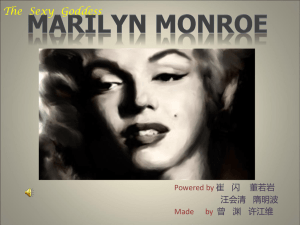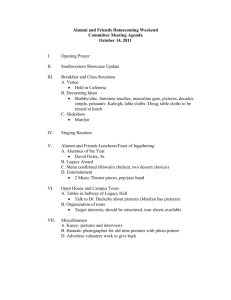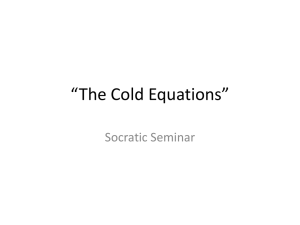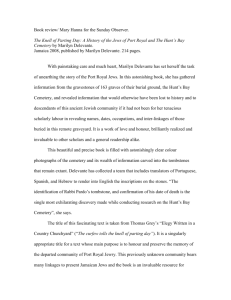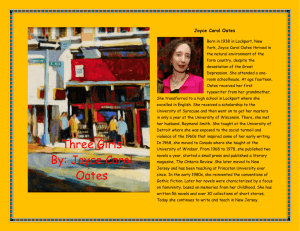JEWISH LIFE IDENTITY_Marilyn
advertisement
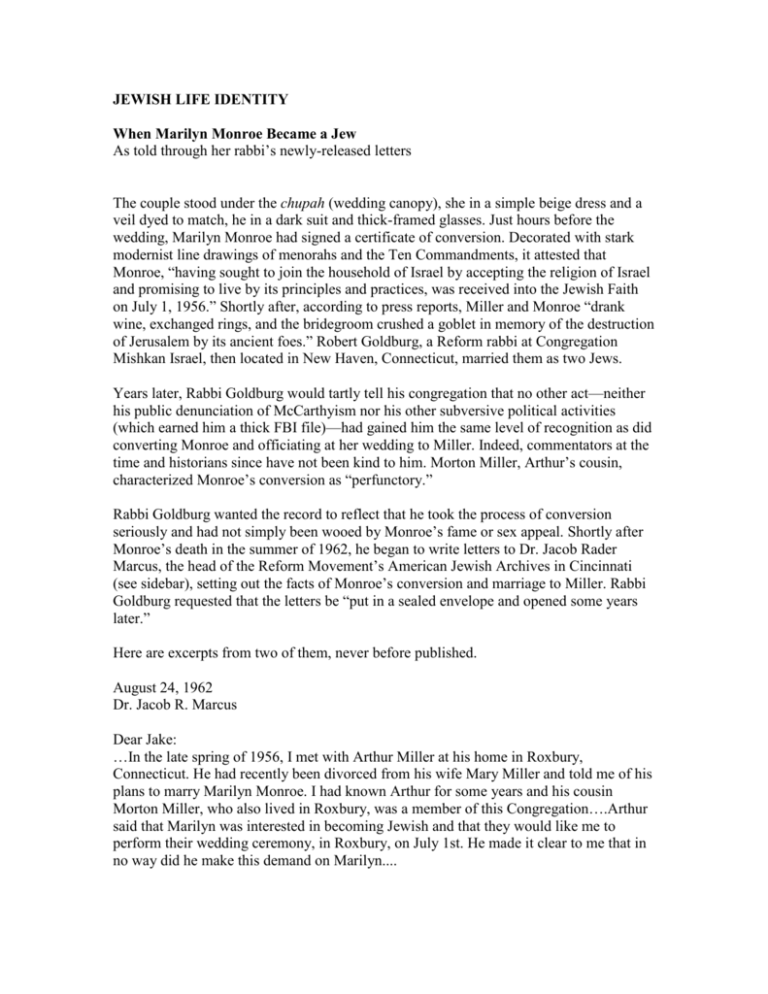
JEWISH LIFE IDENTITY When Marilyn Monroe Became a Jew As told through her rabbi’s newly-released letters The couple stood under the chupah (wedding canopy), she in a simple beige dress and a veil dyed to match, he in a dark suit and thick-framed glasses. Just hours before the wedding, Marilyn Monroe had signed a certificate of conversion. Decorated with stark modernist line drawings of menorahs and the Ten Commandments, it attested that Monroe, “having sought to join the household of Israel by accepting the religion of Israel and promising to live by its principles and practices, was received into the Jewish Faith on July 1, 1956.” Shortly after, according to press reports, Miller and Monroe “drank wine, exchanged rings, and the bridegroom crushed a goblet in memory of the destruction of Jerusalem by its ancient foes.” Robert Goldburg, a Reform rabbi at Congregation Mishkan Israel, then located in New Haven, Connecticut, married them as two Jews. Years later, Rabbi Goldburg would tartly tell his congregation that no other act—neither his public denunciation of McCarthyism nor his other subversive political activities (which earned him a thick FBI file)—had gained him the same level of recognition as did converting Monroe and officiating at her wedding to Miller. Indeed, commentators at the time and historians since have not been kind to him. Morton Miller, Arthur’s cousin, characterized Monroe’s conversion as “perfunctory.” Rabbi Goldburg wanted the record to reflect that he took the process of conversion seriously and had not simply been wooed by Monroe’s fame or sex appeal. Shortly after Monroe’s death in the summer of 1962, he began to write letters to Dr. Jacob Rader Marcus, the head of the Reform Movement’s American Jewish Archives in Cincinnati (see sidebar), setting out the facts of Monroe’s conversion and marriage to Miller. Rabbi Goldburg requested that the letters be “put in a sealed envelope and opened some years later.” Here are excerpts from two of them, never before published. August 24, 1962 Dr. Jacob R. Marcus Dear Jake: …In the late spring of 1956, I met with Arthur Miller at his home in Roxbury, Connecticut. He had recently been divorced from his wife Mary Miller and told me of his plans to marry Marilyn Monroe. I had known Arthur for some years and his cousin Morton Miller, who also lived in Roxbury, was a member of this Congregation….Arthur said that Marilyn was interested in becoming Jewish and that they would like me to perform their wedding ceremony, in Roxbury, on July 1st. He made it clear to me that in no way did he make this demand on Marilyn.... I met Marilyn with Arthur at her apartment in New York at Sutton Place and 57th Street. I don’t remember what I expected but I was struck by her personal sweetness and charm. She seemed very shy. [She] said that she had no religious training other than some memories of a Fundamentalist Protestantism which she had long rejected. She indicated that she was attracted to Judaism by being impressed with Jewish people that she knew, especially Mr. Miller. She said that she was aware of the great characters that the Jewish people had produced and that she had read selections from Albert Einstein’s Out Of My Later Years….She indicated that she was impressed by the rationalism of Judaism—its ethical and prophetic ideals and its concept of close family life. After that meeting we met a number of times and she read a few books that I gave her. These included What Is A Jew? by Morris Kurtzer, [Abram Leon] Sacher’s History of the Jews, Milton Steinberg’s A Partisan Guide to the Jewish Problem, and the Conversion Manual of the CCAR [the Reform rabbinic organization Central Conference of American Rabbis]. We discussed the contents of these books, in part, and I attempted to answer her questions. Marilyn was not an intellectual person but she was sincere in her desire to learn. It was also clear that her ability to concentrate over a long period of time was limited. However, I did feel that she understood and accepted the basic principles of Judaism. Because of the press publicity, in order to keep the marriage ceremony on July 1st a private one, Arthur and Marilyn decided quite suddenly to have a Justice of Peace perform the civil ceremony two days before, in White Plains. They…believed that the photographers and press would then leave them alone so that the wedding would go off as scheduled….The place of the wedding was [also] moved from Roxbury to the home of Arthur’s agent, Kay Brown, in Katonah, New York…. I stayed for the weekend with them in Roxbury…and we drove to Katonah on Sunday morning, July 1st. Before the wedding ceremony, I performed the Ceremony of Conversion which was witnessed by Arthur Miller, Kermit Miller (his brother), Morton Miller, Mr. and Mrs. Lee Strassberg, and Mr. and Mrs. Norman Rosten. Following the Ceremony of Conversion, the wedding ceremony took place. There were no representatives of the press, but Mr. Milton Green, at that time Marilyn’s photographer and agent, took pictures of the wedding which he released to Life Magazine…. During the course of their marriage, I saw them on numerous occasions....[One year] the United Jewish Appeal [UJA] asked me to persuade Marilyn Monroe to be a speaker at the Fountainbleau Hotel in Miami Beach, Florida….Marilyn consented to…tell the assembly why she became Jewish and why she believed that Jewish institutions and Israel deserved support. Just before the arrangements were completed for the three of us to fly to Miami, [UJA leaders] spoke to me.... Arthur Miller had recently been indicted for contempt of Congress [for refusing to acquiesce to demands of the McCarthy hearings] and they withdrew [his] invitation [only]…. [Marilyn did not make an appearance either.]…. [Arthur and Marilyn] didn’t attend synagogue services because they believed that such attendance would turn into a public spectacle. When Arthur’s nephew [became a] bar mitzvah at our temple, Arthur came…but since the press knew of the Miller bar mitzvah they were on hand, as a result of which, at the last moment Marilyn decided to stay in Roxbury. About a year later the American Friends of the Hebrew University invited Arthur Miller to speak in Philadelphia. He consulted me about this and I urged him to accept the invitation. Then I received a call asking me to urge Marilyn to attend…her presence could mean a greater fundraising for the Hebrew University. Marilyn consented to go and we drove down together. Arthur gave a very fine talk and Marilyn sat at the head table and was introduced. In their home they observed Chanu-kah and Marilyn gave presents to Arthur’s children. For two years I conducted a Passover service in Roxbury on the first night of [the] seder, with Arthur and Marilyn participating in the ceremony, at the home of Morton Miller. After the divorce, Marilyn told me that she had no plans to renounce Judaism at any time. She said that it had nothing to do with the divorce and she remained on excellent terms with Arthur’s children and Arthur’s father…. I was in Europe when I read about her tragic death. I have always felt that she was an extremely lovely person who was not able to overcome the terrible emotional burdens which were part of her childhood and which were aggravated by tremendous fame…. Warm personal regards. Rabbi Robert E. Goldburg The Congregation Mishkan Israel Hamden, Connecticut August 6, 1986 Dear Jake: Although I didn’t get to the CCAR at Snowmas, I am well and delighted to hear from you. I am glad that you have come down from the mountains, because it is certainly easier to breathe at sea level…. About Marilyn—most of what has been written about her is at best half-truths which [are] not “truth” and her memory has been exploited for obvious financial gain since she has become an international myth….No pressure was put on Marilyn to convert, by Arthur or me. She had negative feelings towards Christianity (her foster parents were rigid Fundamentalists) and positive feelings towards the Jewish people. She often identified with the “underdog” and at the same time had an enormous respect and admiration for intellectuals. She met Arthur while she was studying and acting in his plays as a student at the Actor’s Studio, and besides Arthur, her “hero” was Albert Einstein…[who] represented for her the great scientist-humanist-Jew-Socialist-dissenter…. Marilyn was a very decent human being….It is true she had many psychological problems—lateness, alcohol (exaggerated), sleeping pills, a feeling of worthlessness, except for her looks—which made it difficult at times to live with her and/or work with her. Arthur did try to make a go of it for five years, and a year later, when Marilyn died, he said, and I agree with him: “With a little luck, she could have made it.” We both believe that her death was accidental suicide. That also was the opinion of the late Dr. Marriane Kris, wife of Dr. Ernst Kris, Marilyn’s analyst during the last years of her life…. …She took acting seriously and tried hard to perfect her craft. Her gift as a wonderful comedienne is evident especially in the movie Some Like It Hot. In her last film, The Misfits, by Arthur Miller, it is evident that she was no slouch in playing a dramatic role. At the same time, that particular role was very much like the real Marilyn: a sensitive girl who could not bear cruelty to animals, much less human beings. I hope all this is what you are looking for. There is nothing confidential here although I have refused numerous offered invitations to write, speak, appear on T.V., etc., over the years. But I can’t resist one of my favorite teachers’ request. With much respect and love. Rabbi Robert E. Goldburg The introduction to this article has been adapted from Lila Corwin Berman’s Speaking of Jews: Rabbis, Intellectuals, and the Creation of an American Public Identity, © 2009 by the Regents of the University of California, published by the University of California Press. Berman is Murray Friedman Chair of American Jewish History and Director of the Feinstein Center for American Jewish History at Temple University. MARILYN MONROE AND ARTHUR MILLER ON THEIR WEDDING DAY, 1956. © INTERFOTO/ALAMY COURTESY OF THE JACOB RADER MARCUS CENTER OF THE AMERICAN JEWISH ARCHIVES Preserving Our History By Dana Herman Why did Arthur Miller’s rabbi, Robert Goldburg, entrust to the American Jewish Archives (AJA) his private reflections about Marilyn Monroe’s conversion to Judaism? Because he knew that AJA founder Dr. Jacob Rader Marcus, known as the “dean of American Jewish historians,” would preserve his letters for posterity in a national Jewish archives that Marcus created in 1947. Located on the Cincinnati campus of the Hebrew Union College, the AJA remains the world’s largest research center dedicated solely to the preservation of the American Jewish experience, with nearly 800 major manuscript collections, 16,000+ smaller collections, approximately 15,000 photographs, and 3,000+ microfilm reels—everything from personal and family papers to the records of local, state, national, and international Jewish organizations. Now under the direction of Dr. Gary P. Zola, it is also the official repository of the Reform Movement in North America, housing Reform rabbis’ sermons and papers; synagogue records; and the Isaac Mayer Wise Digital Archive, an online, fully searchable resource containing the correspondence and writings of the architect of Reform Judaism in America. One of the AJA’s unique treasures is the original Riegner Telegram (the first half of which is shown here), considered by scholars to be the first official communiqué informing American Jewish leaders of the implementation of Hitler’s Final Solution. Donated to the AJA in 1983 as part of the World Jewish Congress (WJC) collection, the report—written by Geneva-based WJC representative Gerhart Riegner—was cabled August 29, 1942 to WJC President Rabbi Stephen S. Wise by British M.P. Samuel Sidney Silverman. The Jacob Rader Marcus Center of the American Jewish Archives is open to scholars, amateur historians, and all others interested in learning more about our American Jewish heritage. Off-site assistance is available via phone (513-221-1875), fax (513-221-7812), and website (www.americanjewish archives.org), where visitors will also discover interactive exhibits and publications, including The American Jewish Archives Journal. The AJA contains more than a million noteworthy stories waiting to be studied and retold. As Dr. Marcus wrote, “A people that is not conscious of its past has no assurance of a future.” Dana Herman, Ph.D., is managing editor and academic associate at The Jacob Rader Marcus Center of the American Jewish Archives. THE FIRST ALERT INFORMING AMERICAN JEWISH LEADERS OF THE IMPLEMENTATION OF HITLER’S FINAL SOLUTION.
